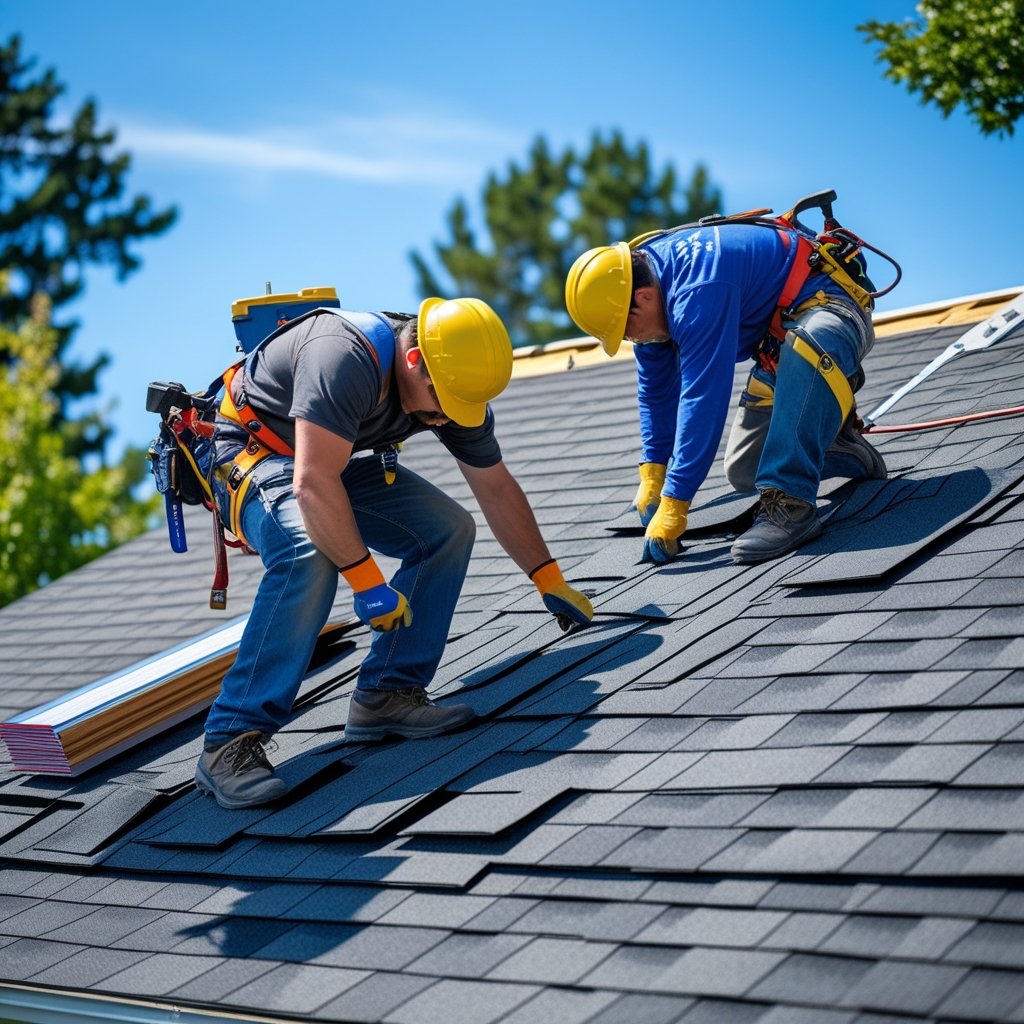If you need roof repairs in Texas, knowing the average cost can help you plan your budget. Most homeowners in Texas spend between $300 and $1,200 on roof repairs, depending on the size of the damage and materials used.
Costs can vary a lot based on how bad the damage is, the type of roof you have, and the local labor prices. Working with a trusted company like Clear Choice Roofing means you get honest pricing and quality work you can depend on.
Whether your roof needs a small patch or more serious fixing, knowing the typical costs up front can save you stress. Your roof protects your home from the Texas heat and storms.
Making smart choices about repairs helps keep your home safe. In this post, you'll learn what to expect for common repair prices and how to keep your roof strong without breaking the bank.
Average Cost of Roof Repairs in Texas
Roof repair prices in Texas vary based on the type of building, roof materials, and the extent of damage. You can expect different costs whether your home or business needs work.
The kind of roof you have plays a big role in how much repairs will cost.
Residential Roof Repair Costs
For homes in Texas, typical roof repairs usually cost between $300 and $1,000. Small fixes like patching leaks or replacing a few shingles fall on the lower end.
Larger jobs like fixing storm damage or replacing sections of the roof push the price higher. The price depends on roof size, material durability, and labor.
Asphalt shingles are the most common and affordable option for residential repairs. Tile or metal roofs cost more because they need special handling.
Always get a free estimate from a trusted roofing company to know your exact cost before work begins.
Commercial Roof Repair Costs
Repairs for commercial roofs generally cost more than residential ones. Larger roof areas and more complex roofing systems increase the price.
In Texas, commercial roof repair prices usually range between $1,000 and $5,000. Materials like TPO, EPDM rubber, or metal are common on commercial buildings and can affect the price.
Repairs might involve patching leaks, fixing drainage, or replacing membrane sections. Your building’s size and roof type directly influence labor and material costs.
Cost Range Based on Roof Type
How much you pay depends heavily on the roofing material. Here’s a quick look at average repair costs by roof type in Texas:
Roof TypeApproximate Repair Cost Range Asphalt Shingles$300 - $1,000Metal$600 - $1,500Tile$700 - $2,000Flat Roof (TPO/EPDM)$800 - $3,000
Some materials need more care and special tools, which add to the cost. Asphalt shingles are easier and cheaper to repair.
Tile and metal roofs last longer but can cost more to maintain. Knowing your roof type helps you prepare financially and schedule the right kind of repair.
Common Roof Repair Issues
There are a few roof problems that happen most often in Texas. Knowing what they are can help you spot trouble early and save money.
These issues mainly involve leaks, damaged shingles, and problems with flashing or vents.
Leak Repairs
Leaks are one of the most common reasons you might need roof repairs. Water can get inside through cracks, holes, or damaged roofing material.
In Texas, heavy rains and storms often cause leaks that need quick attention. If you ignore leaks, they can damage your home’s structure and cause mold growth.
Repairs usually involve finding the exact spot of the leak and replacing or fixing the damaged area. This might mean patching holes, sealing cracks, or replacing shingles.
A good roof inspection is important to avoid repeated problems.
Shingle Replacement
Shingles protect your roof from weather, but over time they can crack, curl, or fall off. Texas heat and storms cause shingles to wear out faster.
Missing or damaged shingles need to be replaced to keep your roof strong and water-tight. Replacing shingles means removing the damaged ones and installing new matches.
Sometimes, nearby shingles also get replaced to ensure a good seal. Using the right materials can make a big difference in how long the repair lasts.
Flashing and Vent Repairs
Flashing and vents help keep water out but often face damage or wear. Flashing is thin metal placed around chimneys, vents, and edges to stop leaks.
Vents allow air to flow in and out of your attic, which helps prevent moisture buildup and heat damage. If flashing cracks or pulls away, water can seep under roofing materials.
Damaged or blocked vents cause poor air circulation, which can lead to mold or rot. Repairs usually involve fixing or replacing the metal flashing and cleaning or fixing vents to keep everything sealed and working well.
By paying attention to these common issues, you can keep your roof in better shape and avoid costly repairs later.
Factors Influencing Roof Repair Prices
Several things affect how much it costs to fix your roof in Texas. The price depends on what materials you need, how big and steep your roof is, how easy it is to reach, and how bad the damage is.
Material Costs
The type of material you use for roof repairs can change the price a lot. Asphalt shingles are common and usually cost less.
Metal or tile roofs tend to be more expensive because the materials cost more and need special tools for repair. If you have a roof that uses more costly materials, expect your repair bill to be higher.
Some materials last longer and handle Texas weather better, which might save you money on repairs over time. Weather-resistant materials have higher upfront costs but can protect your home better against heat, storms, and heavy rain.
Roof Size and Pitch
The size of your roof directly affects how much it costs to repair. Bigger roofs need more material and more time to fix.
A small roof will usually cost less to repair than a large one. The pitch, or how steep your roof is, matters too.
Steeper roofs are harder for workers to access safely. This often means extra labor or safety gear, which raises the price.
Flat or low-slope roofs are easier and cheaper to work on than roofs with sharp angles or multiple levels.
Accessibility and Labor Expenses
How easy it is to get to your roof makes a difference. If your roof is hard to reach, like on a very tall house or surrounded by trees, the job will take more time and special equipment.
This demands extra labor costs. Labor rates also vary by location.
In Texas, urban areas often have higher labor costs than rural places because living expenses influence worker pay. If roofers need to bring in a crane, use drones for inspection, or set up extra safety equipment, the price will go up.
Extent of Damage
The size and type of damage you have will change what the repair costs. A small leak or a few missing shingles will cost less than fixing large areas with water damage or structural problems.
Damage caused by Texas storms, like hail or wind, often requires more work to replace underlayment or fix framing. This can add to your bill.
If hidden damage is found after work starts, the price may increase because extra repairs become necessary. Always ask for a clear estimate upfront to avoid surprises.
Regional Price Differences Across Texas
Roof repair costs in Texas vary depending on where you live and the weather conditions affecting your area. These two main factors play a big role in how much you might pay for repairs.
Urban vs Rural Costs
In cities like Austin, Dallas, or Houston, roof repairs usually cost more. Labor rates tend to be higher in urban areas.
You also have more roofing companies to choose from, so quality and pricing can vary widely. In rural areas, labor may cost less, but materials sometimes take longer to arrive.
This can lead to delays or slightly higher prices for parts. Roofers might also charge extra travel fees if your home is in a remote location.
Urban repairs often involve more complex work due to building codes and permit fees. Rural jobs can be simpler but may still have hidden costs related to travel and supply availability.
Climate Impacts on Repairs
Texas weather can be tough on roofs. In the Hill Country or Central Texas, sudden storms with strong winds and hail are common.
These can cause immediate damage that you need to fix quickly to avoid bigger problems. Coastal areas like Houston face heavy rain and humidity.
This can wear down roofs faster, leading to frequent repairs for leaks or mold. West Texas is hotter and drier.
Sun damage can make roofing materials crack or fade, requiring repairs to protect your home. Knowing your local climate helps you prepare for the kind of repairs you might expect and plan your budget better.
Cost Comparison: Repair vs Replacement
Choosing between roof repair and full replacement depends on how long you want your roof to last and the value you get for your money. Repairs usually cost less upfront but might only fix problems temporarily.
Replacement requires more money but can save you from repeated repairs.
Longevity of Repairs
Roof repairs in Texas usually address specific issues like leaks or damaged shingles. These fixes can extend your roof’s life by a few years, sometimes five or more, depending on the damage and quality of repair work.
If you use a trusted company like Clear Choice Roofing, repairs use quality materials, which helps them last longer. But repairs won’t fix roofing problems that affect the entire structure.
Fixing one spot won’t stop other parts from wearing out. Repairs work best if your roof is generally in good shape but needs minor fixes.
If the roof is old or has many issues, repairs may only delay the need for a full replacement.
Investment Value
Roof repairs typically cost a few hundred to a few thousand dollars, depending on the size and problem. This makes repairs a cheaper option at first but could lead to more costs if problems return.
Replacement costs in Central Texas often range from $5,000 to $15,000, or more for bigger or complex roofs. While this is a bigger upfront cost, a new roof can last 20 to 50 years depending on the material.
Metal roofs cost more but last longer, while shingles cost less but wear out quicker. Replacing your roof adds more value to your home by improving curb appeal and energy efficiency.
It can also help avoid unexpected repair costs. When you invest in replacement, you’re paying for peace of mind and long-term protection.
Tips for Reducing Roof Repair Expenses
You can save money on roof repairs by keeping up with regular care and by shopping around for the best contractor. These two approaches help you avoid big problems and ensure you get fair prices.
Regular Maintenance Strategies
Checking your roof regularly helps catch small problems early, before they turn into expensive repairs. Look for loose or missing shingles, clogged gutters, and signs of water damage.
Cleaning debris and trimming overhanging branches reduce wear and tear. Schedule professional inspections once or twice a year.
Licensed roofers, like those at Clear Choice Roofing, can spot issues you might miss. Fix minor leaks or damages quickly.
Waiting can cause more damage and higher repair costs. Using quality materials during repairs can also extend your roof’s life and lower future expenses.
Comparing Contractor Quotes
Getting several quotes helps you find the best price and service.
Make sure each estimate includes a detailed list of work, materials, and warranties.
Beware of very low bids, which could mean lower quality.
Ask about each contractor’s experience and reviews.
You want someone trustworthy with a strong reputation.
If you’re in Austin or nearby, Clear Choice Roofing offers free estimates.
They are highly rated for honesty and quality work.
Compare offers side by side using a simple table like this:
ContractorPrice EstimateWarranty OfferedIncluded ServicesReviews Score Clear Choice Roofing$2,50010 yearsInspection, materials, labor4.8 / 5Contractor B$2,1005 yearsMaterials, labor4.3 / 5Contractor C$2,8008 yearsInspection, repair4.5 / 5
How to Choose a Texas Roofing Contractor
Finding the right roofing contractor in Texas means paying attention to key details like proper licensing and honest customer feedback.
These points help protect you from problems and ensure you get quality work done on your roof.
Licensing and Insurance
Make sure your roofer has a valid Texas license.
This means they meet state rules and know how to do the job safely.
Without a license, you risk hiring someone who might not be qualified or insured.
Insurance is just as important.
A good roofing company should have both workers' compensation and liability insurance.
If a worker gets hurt or your property is damaged, you won’t be responsible for those costs.
Always ask to see proof of these before signing a contract.
If they hesitate or don’t have them, it’s best to keep looking.
Customer Reviews and References
Check reviews online to see how past customers felt about their work.
Look for companies with many positive ratings and real feedback about honesty, cleanliness, and how well they finished the job.
Ask for references.
Talking directly to past clients can give you a clearer idea of what to expect.
You can ask about the company’s communication, problem-solving, and the quality of the roofing materials used.
Companies like Clear Choice Roofing in Austin have hundreds of positive reviews.
You’ll want a roofer who values their reputation and treats customers with respect throughout the process.
Understanding Roofing Insurance Coverage
When you need roof repairs, your insurance coverage plays a big role in what costs you pay.
Many insurance companies require a roof inspection before they approve repairs or replacements.
This inspection helps them check the current condition of your roof.
If the inspection finds problems, you might need to fix those before your insurance covers anything.
This can mean extra repair costs that aren’t included in your policy’s payout.
Here are some important points about roofing insurance coverage:
- Deductibles: The amount you pay out of pocket before insurance pays.
- Coverage limits: Your policy might only cover certain costs or damages.
- Claim timing: Filing a claim soon after damage happens can improve your chances of coverage.
- Inspection requirements: Some insurers want a new inspection if your roof is older or has had damage before.
Keep your roof in good shape to avoid costly repairs that insurance might not cover.
Working with a company like Clear Choice Roofing can help.
They assist you with the insurance claim process and make sure paperwork is clear.
Seasonal Trends Affecting Roof Repair Costs
The time of year can impact how much your roof repairs will cost.
In Texas, spring and fall are usually the best seasons for roofing work.
The weather is mild and dry, which helps materials set properly.
During summer, hot temperatures can cause problems.
Roofers may work slower because of the heat, which can raise labor costs.
Extreme heat can damage some roofing materials, leading to more repairs.
In winter, storms and cold snaps can cause leaks or damage.
Fixing your roof in colder months might be more expensive due to harder working conditions and possible delays.
Here’s a quick look at how seasons affect costs:
SeasonImpact on Roof RepairsCost Tendency SpringMild weather, fewer delaysModerate to LowSummerHeat slows work, materials at riskPossible increaseFallDry, cool conditions idealModerate to LowWinterCold, storms cause more damageOften higher
You can save money by scheduling repairs during spring or fall.
At Clear Choice Roofing, we help you pick the best time so your project goes smoothly.
Getting your roof checked regularly can prevent major repairs.
Planning ahead for the season can save you time and money on fixing your roof.
Frequently Asked Questions
Roof repair costs in Texas vary based on the size of your home, type of damage, and materials used.
Knowing average prices and common expenses can help you prepare your budget better.
What's the ballpark figure for repairing a residential roof in the Lone Star State?
On average, roof repairs in Texas can cost between $300 and $1,200.
Minor issues like fixing a few shingles are on the lower end, while larger repairs raise the price.
Can anyone share insights on how the size of the house impacts roof repair expenses in Texas?
The bigger your house, the more materials and labor you’ll need.
Larger roofs usually mean higher repair costs because of the extra space that needs fixing.
Are there any rough estimates for re-roofing per square foot costs in Texas?
Re-roofing typically costs around $5 to $8 per square foot.
This price depends on the roofing material and labor fees in your area.
What can I expect to budget for a complete roof replacement on my mid-sized Texas home?
For a full replacement, expect to pay between $7,000 and $15,000.
This varies with your roof size, materials, and current condition.
Could someone break down the costs involved in fixing storm damage to roofs in Texas?
Storm damage repairs can cost anywhere from a few hundred to several thousand dollars.
It depends on how bad the damage is—hail, wind, or water leaks all affect the price.
What are the hidden expenses to watch out for when budgeting for roof repairs in Texas?
Watch for inspection fees and permit costs. Debris removal can also add to your expenses.
Sometimes, you may find unexpected issues like rotted wood. Insurance deductible payments can also increase your total costs.



